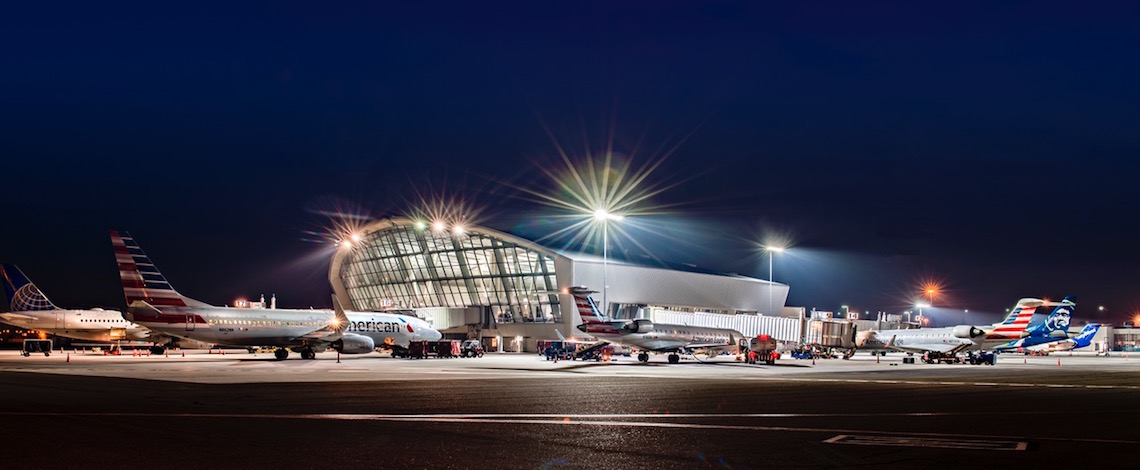
Fresno Yosemite International Airport image via City of Fresno.
Written by Frank Lopez
As the coronavirus traveled from city to state to country, it has sent the tourism and travel industry in a downward spiral.
In mid-April, the Treasury Department landed a deal with 10 major airlines for a $25 billion bailout to prop up the industry, part of the $2.2 trillion federal stimulus package approved by Congress last month.
Because of the drop in demand for travel, including at Fresno Yosemite International Airport (FAT), the local airport will receive about $13 million in COVID-19 relief funds from the stimulus.
Kevin Meikle, director of aviation at FAT, said the airport is experiencing the same downturn as all other airports across the U.S.
Fresno airport posts another ‘FAT’ year with 1.96M passengers
Since late March, travel at the airport was down 95-97% compared to normal. Over the last week, Meikle said the airport has been hovering at around 90%, which shows a slight pickup.
This comes off of several years of record growth.
“Generally, it’s way down—far worse than we’ve ever seen before, with the exception of that short window of time we saw during 9/11,” Meikle said.
To illustrate, Meikle said on an average May 5, the airport would normally see about 2,700 passengers go through the security checkpoint. This past May 5, there were only 245 passengers.
Come the holidays, Meikle said that the general consensus in the industry is that it may be at about a 50% recovery rate back to normal levels. Recovery won’t be overnight.
Some airlines are projecting a 50% recovery rate by this summer, with this optimism being spurred by increased bookings, the economy slowly re-opening and efforts to increase public confidence with cleanliness and health protocols.
FAT sees about a 50/50 split between business and leisure travel, which Meikle said is a healthy ratio.
“Those markets that are primarily leisure, you may find to be slower to recover than those that do have a business component,” Meikle said. “Being a 50/50 split is really the right place to be. When we look at past events—9/11/, the Great Recession of 2008—our airport recovered twice as fast as the national average.”
Though the industry isn’t on a final approach to full recovery just yet, Meikle said the airport is staying in step with the airlines to be ready for when customers start to travel again.
Meikle expects airlines to become very competitive with pricing to bring back public confidence in safe air travel.
Currently, tourist travel to the airport is dependent on when the economy starts to reopen, as well as the re-opening of national parks and other tourist attractions in the state.
There have been no layoffs, furloughs or reduction of hours at the airport, Meikle said, which isnt unique to just FAT.
There are more than 1,000 workers at the Fresno airport, with only 120 airport department workers, and the rest working for the Transportation Security Administration (TSA), Custom Border’s Protection, rental car agencies, restaurants, parking lot operators, etc.
“For an airport, even if there are very little passengers, we’ve got to keep this thing opened, cleaned and operating,” Meikle said. “There are FAA requirements associated with that, but even with almost no passengers, we are almost at full staff, we don’t have a choice not to be.”
Airlines and stakeholders don’t want to layoff or furlough their workers, which would require them to do extensive background checks for new employees. They are looking for ways to keep their workers busy.
Alaska Airlines approached FAT to see if there was any work for its employees to do, and replaced the volunteers at the information desk, which is usually staffed by retirees. The program was suspended at this time to keep the older employees safe.
Meikle said that airports are developing health and safety protocols that will resemble ones that retail stores are implementing, including designated entrance and exit doors, guidance stickers on the floor and sneeze guards.
The restaurants and shops in the airport have had to significantly reduce their operations. The Starbucks in the main lobby before check-in is closed, but the Starbucks and other eateries and shops behind the check-in is only open for arrivals and departures.
“We are ready, we have the proper protocols in place to accommodate the passengers as the numbers begin to increase,” Meikle said. “We anticipate it happening this summer, and through the fall and through the holidays. In about a year from now we should be, maybe not quite back to where we were before it started, but close.”






